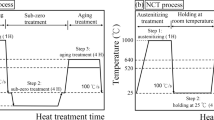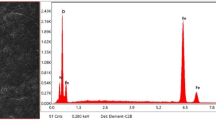Abstract
The definition of the practical upper temperature limit of the bainite reaction in steels is discussed. Because the theoretical upper temperature limit of bainite reaction, B 0, can neither be obtained directly from experimental measurements, nor from calculations, then, different models related to the practical upper temperature limit of bainite reaction, B S, are reviewed and analyzed first in order to define the B 0 temperature. A new physical significance of the B S and B 0 temperatures in steels is proposed and analyzed. It is found that the B 0 temperature of the bainite reaction in steels can be defined by the point of intersection between the thermodynamic equilibrium curve for the austenite→ferrite transformation by coherent growth (curve Z\(\gamma \to \overrightarrow \alpha \)) and the extrapolated thermodynamic equilibrium curve for the austenite→cementite transformation (curve ES in the Fe-C phase diagram). The B S temperature for the bainite reaction is about 50–55 °C lower than the B 0 temperature in steels. Using this method, the B 0 and B S temperatures for plain carbon steels were found to be 680 °C and 630 °C, respectively. The bainite reaction can only be observed below 500 °C because it is obscured by the pearlite reaction which occurs prior to the bainite reaction in plain carbon steels. A new formula, B S(°C) =, 630-45Mn-40V-35Si-30Cr-25Mo-20Ni-15W, is proposed to predict the B S temperature of steel. The effect of steel composition on the B S temperature is discussed. It is shown that B S is mainly affected by alloying elements other than carbon, which had been found in previous investigations. The new formula gives a better agreement with experimental results than for 3 other empirical formulae when data from 82 low alloy steels from were examined. For more than 70% of these low alloy steels, the B S temperatures can be predicted by this new formula within ±25°C. It is believed that the new equation will have more extensive applicability than existing equations since it is based on data for a wide range of steel compositions (7 alloying elements).
Similar content being viewed by others
References
W. Steven and A. G. Haynes, J.Iron Steel Inst. 183 (1956) 349.
J. Zhao, Mater.Sci.and Tech. 8 (1992) 997.
R. L. Bodnar, T. Ohhashi and R. I. Jaffee, Met. Trans. 20A (1989) 1445.
R. F. Hehemann, K. R. Kinsman and H. I. Aaronson, ibid. 3 (1972) 1077.
H. I. Aaronson, “The Mechanism of Phase Transformations in Crystalline Solids” (The Institute of Metals, London, 1969) p. 270.
E. S. Davenport and E. C. Bain, Trans.Met.Soc.A.I.M.E. 90 (1930) 117.
C. Zener, Trans.Amer.Inst.Min.Met.Eng. 167 (1946) 550.
K. R. Kinsman and H. I. Aaronson, “Transformation and Hardenability in Steels” (Climax Molybdenum Co., Ann Arbor,MI, 1967) p. 39.
A. Hultgren, Jerkontorets Ann 135 (1951) 403.
J. R. Blanchard, R. M. Park and A. J. Herzig, Trans.Amer.Soc.Metals 29 (1941) 317.
J. C. Fisher, “Thermodynamics in Physical Metallurgy” (Amer. Soc. Metals, Cleveland, OH, 1950) 201.
T. Lyman and A. R. Troiano, Trans.Amer.Soc.Metals 37 (1946) 402.
A. P. Gyljaev, “Thermodynamics Development of Steels” (Mashgis, Moscow, 1960) p. 60 (in Russian).
M. E. Blanter, “Phase Transformation on the Thermodynamics Development of Steels” (Metallurgisdat, Moscow, 1962) p. 129 (in Russian).
O. Kriesement and F. Wever, in Symposium on the Mechanisms of PhaseTransformation in Metals, Monograph and Rep. Ser. no 18 (Applied Science Publishers Ltd., London, 1955) p. 253.
S. A. Leont'ev, Physics of Metals and Metallurgy 16 (1963) 516 (in Russian).
H. Krainer, M. Kroneis and R. Gatteringer, Archivf¨ur das Eiserhüten Wesen 26 (1955) 131 (in German).
H. I. Aaronson, H. A. Domain and G. M. Andes, Trans.Met.Soc.A.I.A.E. 236 (1960) 753.
H. I. Aaronson, Trans.Met.Soc.A.I.M.E. 212 (1958) 212.
Z. Zhao, C. Liu, D. O. Northwood and D. Wang, Rare Metal Materials and Engineering 28(4) (1999) 206 (in Chinese).
J. M. Robertson, J.Iron Steel Inst. 119 (1929) 391.
E. S. Davenport and E. C. Bain, Trans.Met.Soc.A.I.M.E. 90 (1930) 117.
Z. Zhao, D. O. Northwood, C. Liu, Y. Liu and D. Wang, in The Third Pacific Rim International Conference on Advanced Materials and Processing (PRICM3), edited by M. A. Imam et al. (The Mineral, Metals & Materials Society, 1998) p. 193.
M. Cohen, E. S. Machlin and V. G. Paranjpe, “Thermodynamics in Physical Metallurgy” (Amer. Soc. Metals, New York, 1949).
Yunxu Liu, “Principles of Heat Treatment” (Mechanical Industry Press, Beijing, 1981) p. 76 (in Chinese).
S. V. Radcliffe, M. Schatz and S. A. Kulin, J.Iron Steel Inst. 201 (1963) 143.
T. Ko and J. Zhao, Acta Metallurgica Sinica 1 (1956) 201 (in Chinese).
R. F. Mehl, C. S. Barrett and D. W. Smith, Trans. Met.Soc.A.I.M.E. 105 (1933) 218.
R. F. Mehl and A. Dube, “Phase Transformation in Solids” Wiley, (New York, 1955) p. 99.
A. Ali and H. K. D. H. Bhadeshia, Mater.Sci.and Tech. 6 (1990) p. 781.
H. Krainer, M. Kroneis and R. Gatteringer, Archivfür das Eiserhüten Wesen 26 (1955) 131 (in German).
Cheng Liu, Ph. D. dissertation, Harbin Institute of Technology, Harbin, China, 1998 (in Chinese).
H. E. Boyer, “Atlas of Isothermal Transformation and Cooling Transformation Diagrams” (Amer. Soc. Met., Metals Park, OH, 1977) p. 52.
Author information
Authors and Affiliations
Rights and permissions
About this article
Cite this article
Zhao, Z., Liu, C., Liu, Y. et al. A new empirical formula for the bainite upper temperature limit of steel. Journal of Materials Science 36, 5045–5056 (2001). https://doi.org/10.1023/A:1011874708194
Issue Date:
DOI: https://doi.org/10.1023/A:1011874708194




